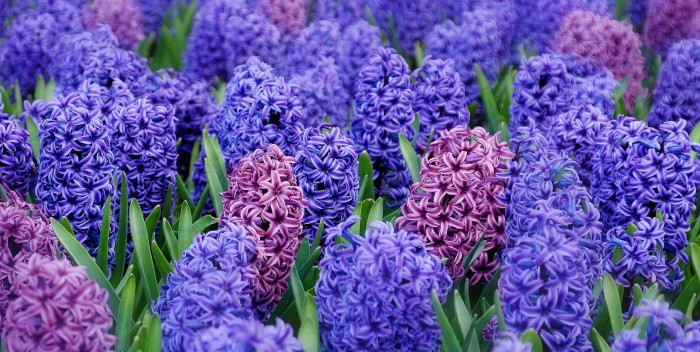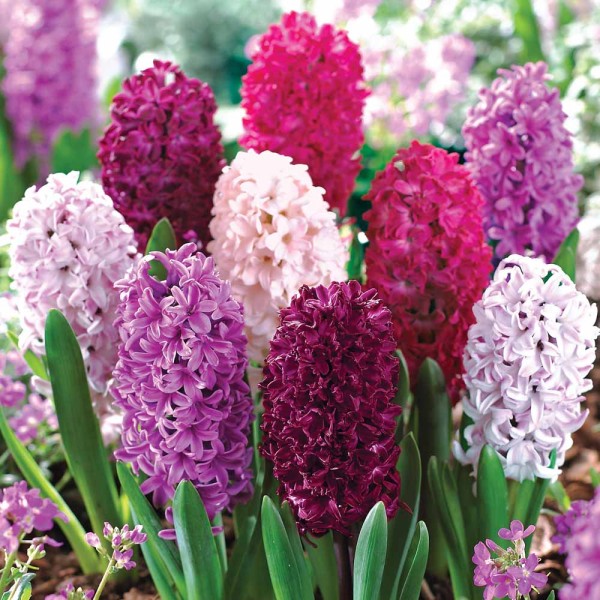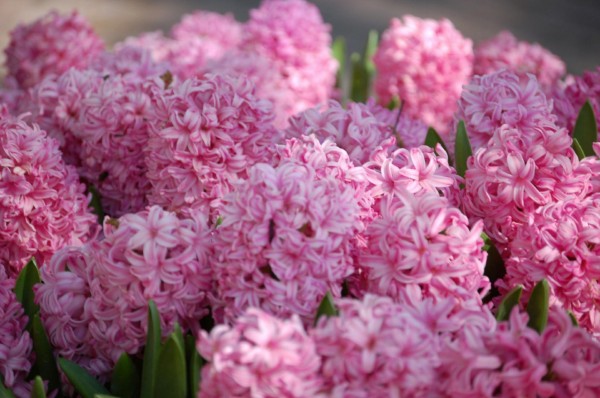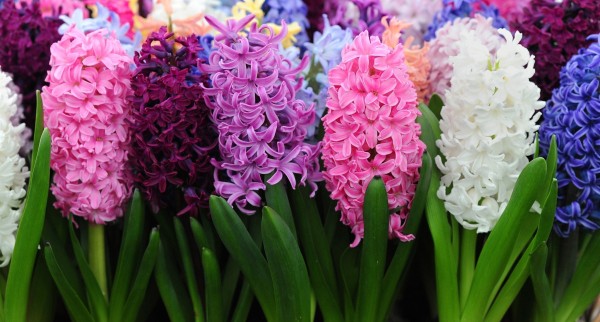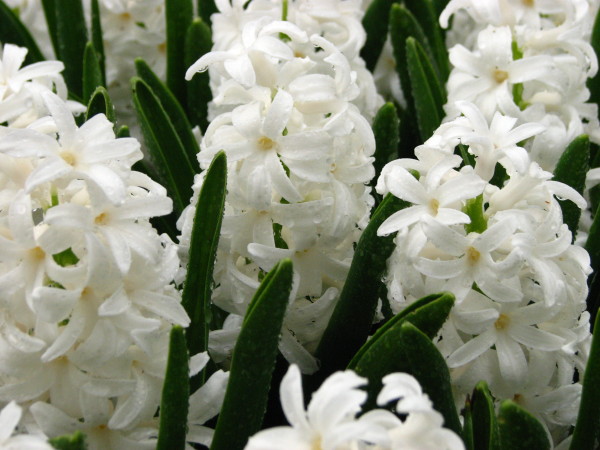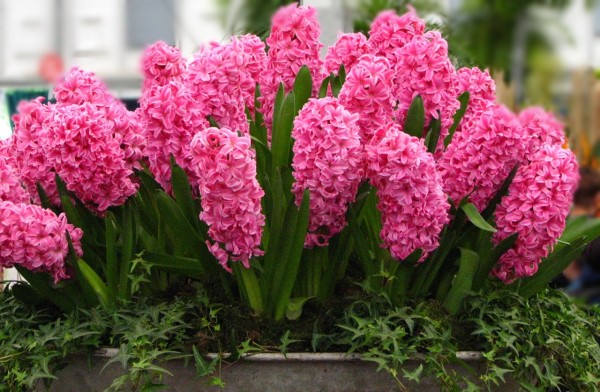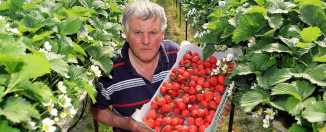Hyacinths: planting and care at home
Hyacinths are early spring flowers. It originated in the Middle East, but most of the varieties and varieties of hyacinth were bred in Holland. This country has done a lot to popularize this flower.
Content
Hyacinth planting
You can grow these beautiful flowers on your own on your site or even in an apartment. Hyacinths are perennial plants that are grown from bulbs. Like many other perennials, they are accepted plant in the middle of autumn. The best time to plant is early October. So, before the onset of cold weather, the hyacinth will have time to take root well, but at the same time it will not have time to start growing before the cold weather.
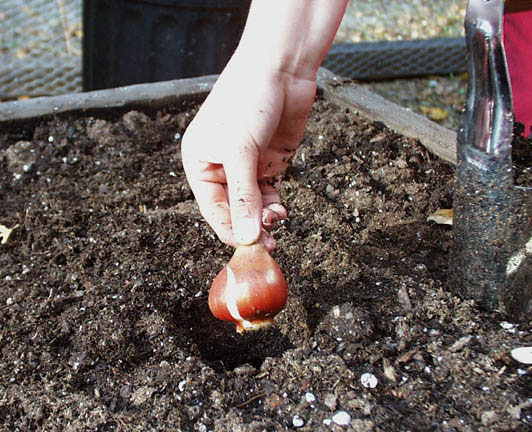 First, prepare the soil for planting the plant. Dig up the site and add mineral fertilizers and humus or compost. For planting, experienced gardeners are advised to select medium-sized bulbs. These bulbs will produce plants that are resistant to changes in weather conditions. Go through the seed and remove damaged, soft and diseased bulbs. Put the remaining good bulbs in the fungicide solution for half an hour.
First, prepare the soil for planting the plant. Dig up the site and add mineral fertilizers and humus or compost. For planting, experienced gardeners are advised to select medium-sized bulbs. These bulbs will produce plants that are resistant to changes in weather conditions. Go through the seed and remove damaged, soft and diseased bulbs. Put the remaining good bulbs in the fungicide solution for half an hour.
Plant the bulbs to a depth of 18 centimeters, keeping the distance between the specimens 15 centimeters, and keep 20 centimeters between the individual rows. After planting the bulbs, water them if the soil is dry.
Hyacinth varieties
Among all the variety varieties the most popular hyacinths are:
- Hyacinths White pearl have white double flowers and bell-shaped, collected in dense inflorescences. They begin to bloom in early or mid-spring.
- The Louvre variety has beautiful blue flowers. It can be used both outdoors and as a houseplant.
- The variety Yellow Queen has flowers of a yellow-lemon color with an amazing aroma. It can be used as a stand-alone plant for dyeing flower beds, or in combination with other flowers.
- One of the first to bloom is the Crystal Palace hyacinths. This plant is distinguished by double-purple flowers. This variety is very fond of flower growers all over the world; it often participates in various exhibitions and competitions.
Hyacinth transplant
The place where hyacinths grow should be changed regularly. The explanation for this is simple - over time, pests and pathogens accumulate in the soil. Therefore, it is necessary to change the area for hyacinths annually. Plants can be planted in the same place only if there are no bulbous plants there for three years.
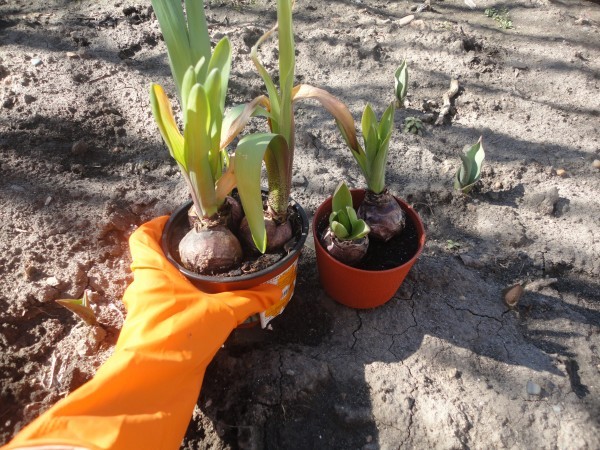 Transplant used, as a rule, for indoor hyacinths. First, cut off the already faded peduncle. Then prepare a larger pot for the plant. Be sure to put drainage on the bottom. Then transfer the hyacinth to a new pot using a transfer method. This way you will not damage the delicate roots of the plant. Pour ready-made soil mixture for flowering plants on the sides. To protect the top layer of soil from drying out, pour a centimeter layer of sand on top.
Transplant used, as a rule, for indoor hyacinths. First, cut off the already faded peduncle. Then prepare a larger pot for the plant. Be sure to put drainage on the bottom. Then transfer the hyacinth to a new pot using a transfer method. This way you will not damage the delicate roots of the plant. Pour ready-made soil mixture for flowering plants on the sides. To protect the top layer of soil from drying out, pour a centimeter layer of sand on top.
Hyacinth at home
These beautiful flowers can be successfully grown indoors. For this growing method, bulbs with a diameter of 5 centimeters or more are suitable. A hyacinth pot will work wide but not deep with drainage holes. It is better to buy soil at a flower shop. Choose a special soil mixture for flowering plants.
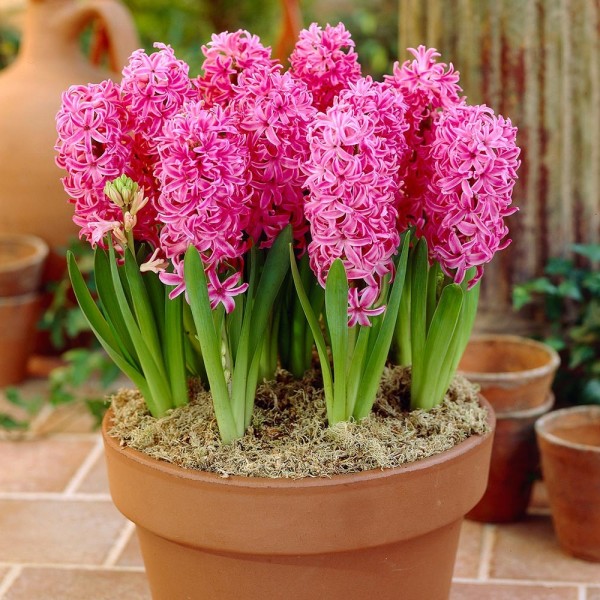 Place a layer of drainage and a small layer of soil at the bottom of the pot. Then pour a thin layer of sand on which the bulbs should be placed at a distance of 3 centimeters from each other. Press the bulbs into the soil and cover with soil mixture. Put a layer of sand on top again. The tops of the onions must be open.
Place a layer of drainage and a small layer of soil at the bottom of the pot. Then pour a thin layer of sand on which the bulbs should be placed at a distance of 3 centimeters from each other. Press the bulbs into the soil and cover with soil mixture. Put a layer of sand on top again. The tops of the onions must be open.
Place the pot of bulbs in a dark place for a month. The temperature in this room should not exceed 5-10 degrees. Water the hyacinths periodically to keep the topsoil from drying out. After a month, return the hyacinths to the room, placing them away from heating appliances.
Outdoor hyacinth
A well-lit and wind-protected place is suitable for this plant. It is best to plant hyacinths in loose soil. If your site has clay or black soil, then mix it with river sand or peat. The application of organic fertilizers has a beneficial effect on the growth process and the duration of flowering.
Hyacinth bulbs react very poorly to the presence of groundwater or poor drainage. They start to rot and the plant stops growing. To avoid this, make a thick layer of drainage or plant hyacinths in tall beds.
Hyacinth care
Important for good flowering right to water hyacinths. During the flowering period, the plant must be watered often and in large quantities. At the same time, try not to touch the flower buds and the inner side of the leaves when watering.
Twice a month feed hyacinths with fertilizers. Use phosphorus or nitrogen fertilizers to stimulate flowering. For the fertilizer to penetrate into the soil and transfer to the roots, water the flower after feeding. Do not forget to be sure to loosen the soil, do it carefully so as not to damage the roots of the plant.
Hyacinth propagation
Most often, hyacinths are propagated by cutting out the bottom. It is best to carry out this procedure in early summer. To do this, take a healthy onion, rinse and dry. A week later, the bottom is cut out with a sharp knife together with the central kidney. The incision site is powdered with crushed activated carbon. Then the bulbs are placed with an incision upwards in a container lined with perlite. To create a favorable microclimate, place the container with the bulbs in a plastic bag.
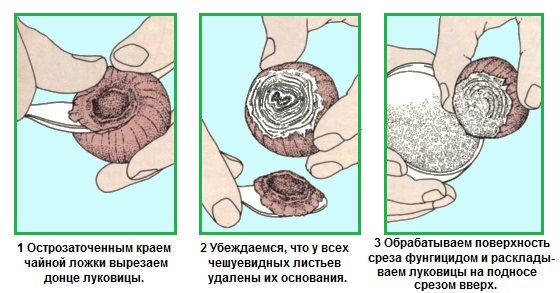
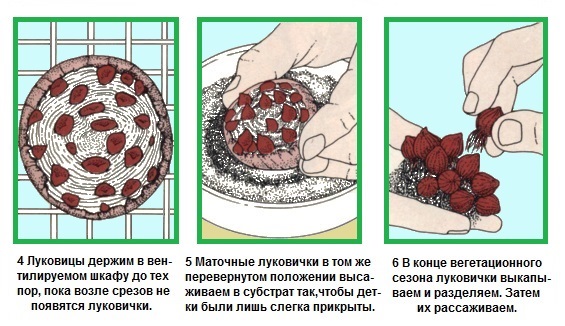 Spray the bulbs frequently and keep them warm for successful germination. The temperature should be above 30 degrees. After three months, if all conditions are met, small bulbs with roots will appear at the incision site.
Spray the bulbs frequently and keep them warm for successful germination. The temperature should be above 30 degrees. After three months, if all conditions are met, small bulbs with roots will appear at the incision site.
